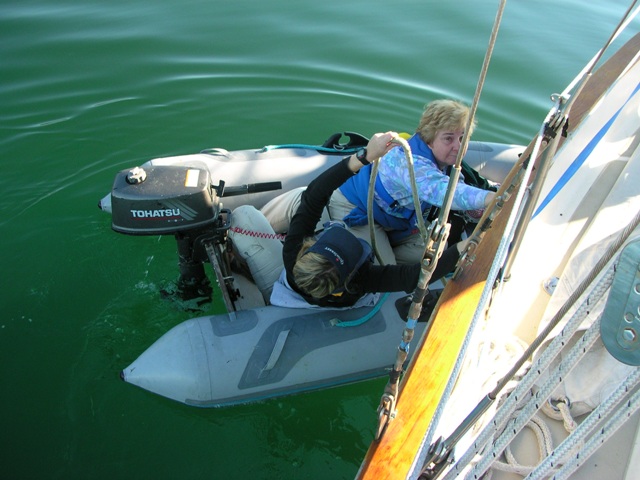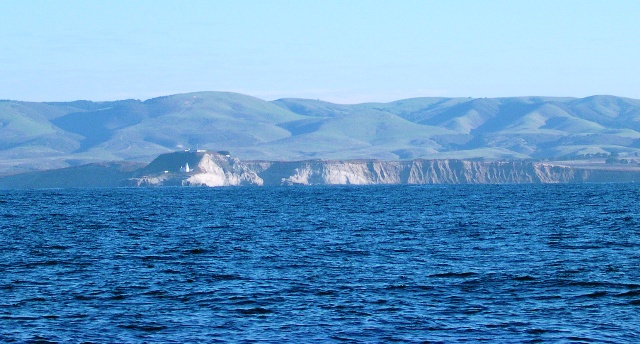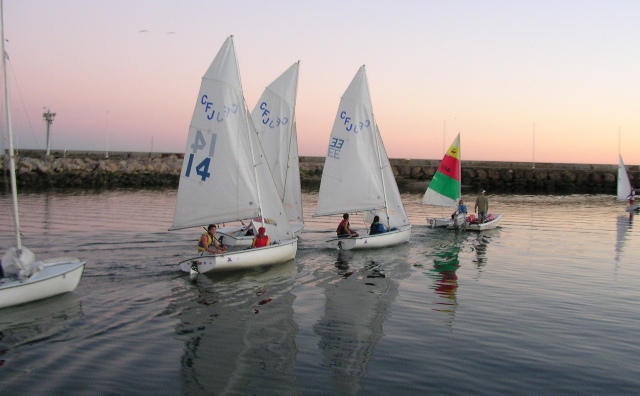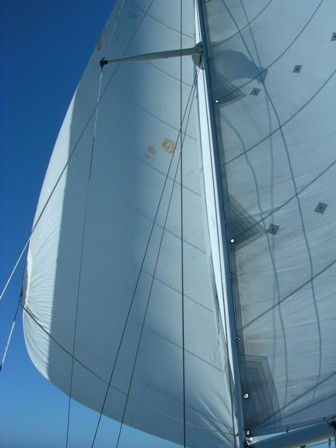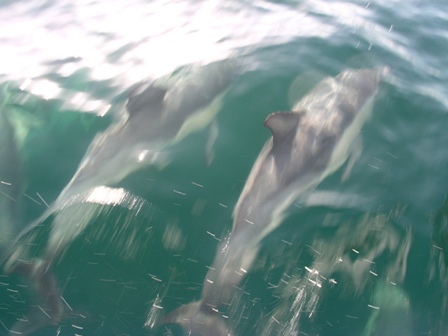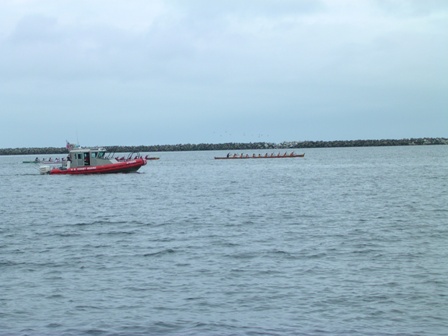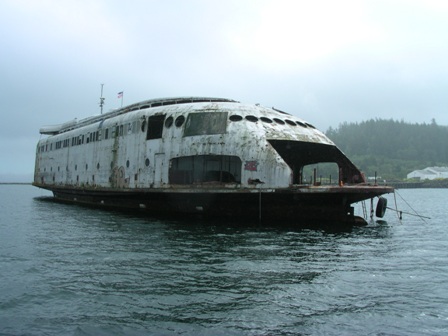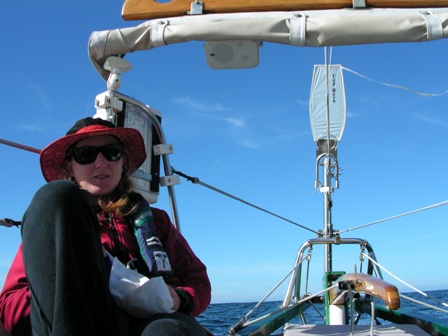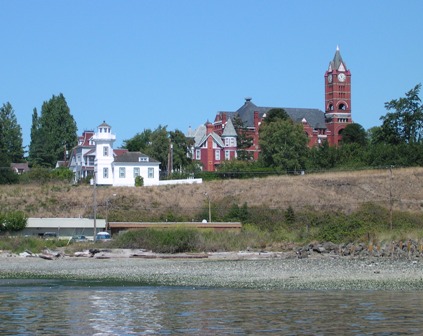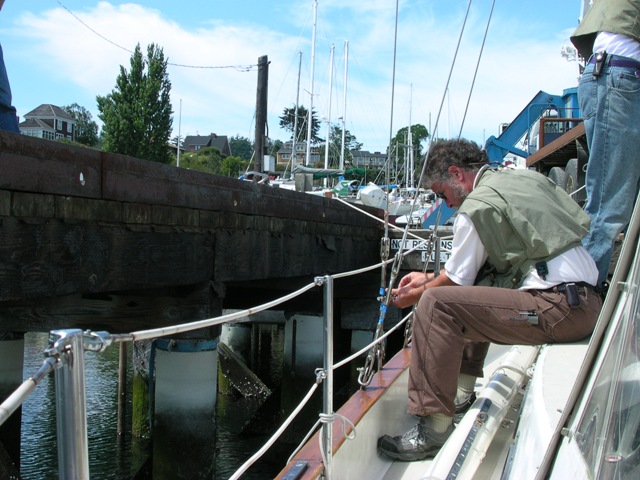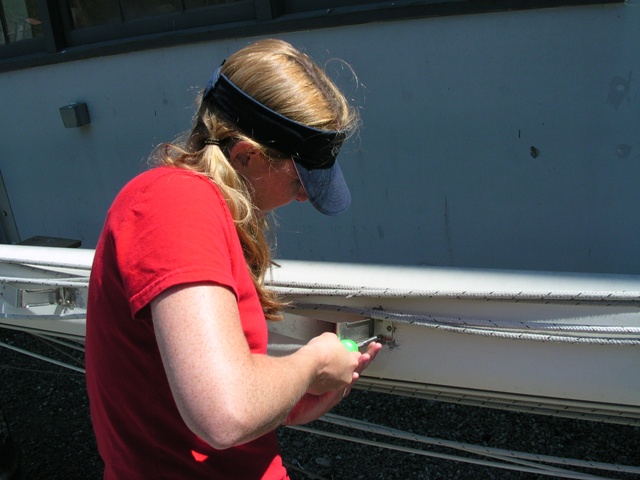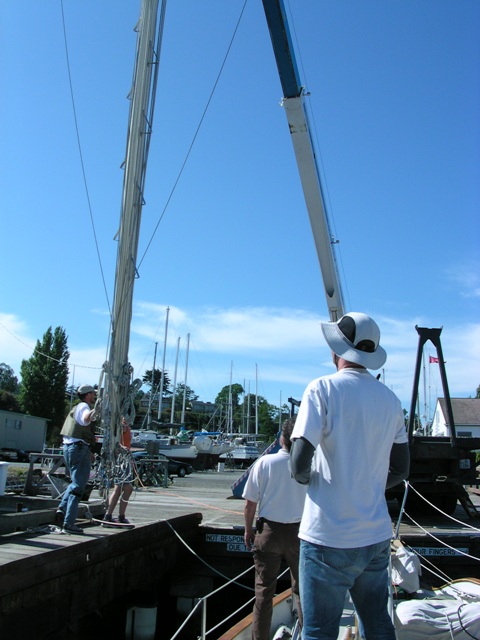 |
|||||||||
|
|
|
|
|
|
|
|
|
|
|
|
|
|
|

Note: to get the
full story in chronological order start at the bottom of the page
San Diego, CA
(Warren) After some serious napping and chilling out during our
first day in SD we were ready to see a few sites (before tackling
the boat's TODO list). Shelter Island is located about five
miles north of downtown so we had a nice bus and trolley ride,
although we were surprised how much more expensive public-trans is
here compared to Seattle.
After checking out the scenery in the gas light district we found
ourselves on the deck of the retired (in 1991) navy carrier
Midway. For $13 you can visit the crew quarters, mess,
hangar bay, flight deck, nav station and bridge. The ship is
staffed by all retired Navy personnel who are full of interesting
info about the history of the ship and her operations.
Now, for why I really wanted to make the trip downtown ... the HMS
Rose, now called the HMS Surprise from the movie Master and
Commander was recently added to the permanent collection of the
waterfront maritime museum!! There are several boats to tour,
including the vast Star of India, which I checked out on the
last trip, but to see Surprise was the highlight of this stop for
me. The rigging is so incredibly complex -- and to think that
people ask us how we "know how to pull on all those ropes?!"
Unfortunately we left the camera behind for this jaunt.
On the way back to the cops' docks we stopped at the huge West
Marine here, supposedly the biggest in the world. They have
everything, at every price. We had two items on our list and
came out with the usual bag full of stuff. It's a great store;
they even provide free Internet access (open 'till 2000 too).
After discovering that our genoa had some small tears near the clew
we picked up a great book on sail care called The Sailmaker's
Apprentice by the same publisher as Brion Toss' book. We
also called the good folks at Hasse Sails and Co. in PT for their
excellent advice (thanks Will!).
In addition to repairing the sail we have a few other items on the
list before departure: topping up our propane, taking on ice,
backing up the laptop, doing laundry, replacing the stop-solenoid
wire which is always shorting out, and try to track down the cause
of the oil leak in the engine. The WX looks good for the next
couple of days, we'll try to head to Cabo on Sunday or Monday.
After that our moorage rates double to $20.
Santa Barbara, CA to Ensenada, Mexico
(Steph) We left Santa Barbara around noon, with some fair wind.
Warren was determined to master our Cape Horn wind vane, so we
steered a bit off course to get the wind comfortably 90 degrees over
the stbd beam. Unfortunately, as soon as we were getting the hang of
it, the wind died down to about 2 knots. This set the tone for the
rest of the voyage. For every 2 hours of fair wind we got, there
were 12 hours of absolutely no wind.
Fully willing to add another item to the long list of possible
sailors' superstitions, it has occurred to me that it was all my
fault. I decided to finally try ocean sailing without a dose of
seasickness medicine. I've been on scopalomine every leg of the trip
since Port Townsend. I'm not a total hypochondriac -- I'm positive
that at many points along the way, it was absolutely necessary to
keep me from going totally out of my mind with nausea. But its side
effects are so unpleasant (extremely blurry near-sightedness and dry
mouth, nose, skin, etc.) that I've decided I need to figure out
exactly when my sea legs fail so that I can avoid the scop when I
won't need it. Of course, the weather doesn't always do what you
expect it to do, but I hated being constantly medicated. I felt
great on this leg, considering it was like powerboating on a lake.
It was so calm, there weren't even swells. Welcome to southern
California sailing, I guess.
Around noon on Tuesday, upon confirming the winds would remain calm
for the next few days, we decided we'd have to refuel to comfortably
make it to Ensenada. Having planned to commit the ultimate west
coast cruiser sin of skipping San Diego, our evil plot was thwarted.
To San Diego we steered!
We expected to arrive around 0100, which is just no good. Arriving
at night in an unfamiliar place is always a bad idea. You're tired,
your judgment and reaction time may be slow, you don't know where
you're going and to make things worse you can't see -- you get the
picture. Another snag is that San Diego requires a permit to anchor
anywhere. If you didn't acquire your permit in advance, you can only
get a permit during working hours after you've arrived. So unless
you have a cozy little slip waiting for you at a marina, you're out
of luck.
We were out of range to call ahead to reserve a slip until 2200. We
finally came into range and called the harbor police, who have a
public dock with limited slip space. We were told that they only
assign slips between 8:00 and 5:00. And no, we could not anchor
until morning. I didn't expect to be able to find a private marina
slip at that hour, so I kept hounding the woman with the harbor
police until she finally conceded that we could tie up to one of
their quarantine mooring balls as long as we left it by 0800. Phew!
Upon approaching the harbor, the stress factor increased
considerably. Finding a place to tie the boat for the night was the
least of our worries. With all the lights on shore, it was
incredibly difficult to spot the channel buoys that would guide us
into the harbor. I was at the tiller while Warren alternatively
checked the chart, ran up to the bow with the binoculars, and shone
his powerful flashlight on obstructions like crab pots and floating
kelp. I didn't even note the tug boat that was quickly approaching
us until it was just 1/4 mile away. Usually their lights are bright
and distinctive, but with all the shore lights, I hadn't spotted it
till then. The tug's sequence of lights (three white lights stacked
up in a column) indicated that it was either a tug of >50 meters or
that it was towing a cable of >200 meters. That's pretty darn
alarming in a narrow channel. I was desperately trying to spot where
its tow was located, and finally spotted a large black void (it cut
out the shore lights) that was moving fairly far back from the tow.
I was steering as far to the right of the channel as I could, to
give the tug plenty of room, which still wasn't comfortably enough
for our taste. Soon after the tug passed us, Warren started urging
me to steer back into the center of the channel. I thought he was
nuts -- we hadn't passed the tow yet. I shouted to him that I wanted
to give the tow a wide berth, and he said, "We've already passed the
tow! Look to your left." I looked and saw that we were indeed
passing the tow at that very moment. A little barge-like thing on a
cable that was probably 20 feet long. So much for the tug
advertising its size accurately.
I decided that the hulking black void must be something on shore,
maybe a building. Happy to have survived the tug, we continued on,
keeping an eye out for our channel markers. My slow-reasoning mind
was trying to wrap itself around another strange thing I was looking
at in the channel. The big, black void I had originally thought was
the tug's tow, then decided was a building, was now definitely a
giant ship quickly closing the gap between us. It was even less than
1/4 mile away when I finally figured it out. And Warren hadn't even
spotted it at this point. I muttered to myself, "This is totally
suicidal." I seriously thought this might be the time when we'd live
to regret entering an unfamiliar harbor at night. I hoped we'd live,
anyway.
We managed to avoid the huge ship and dropped our speed to just a
couple knots so that we could figure out how to enter the channel to
the police docks and their quarantine balls, which are located on a
little finger of land called Shelter Island. Warren was down in the
cabin studying the chart, when a 17 ft. inflatable boat with about
10 coast guard guys came speeding up to us. "Uh, Warren, get up
here. We're being approached!" We slowed down, and proceeded to
answer their questions, which consisted of asking us where we'd come
from about three times. I guess they wanted to catch us in a lie, so
we'd finally admit we'd come from Tijuana and had 20 Mexicans
aboard. They finally let us go, but not before pointing out that we
should try to avoid the channel buoy that we were about to run into.
We finally located the entrance to the Shelter Island channel, and
entered it at a snail's pace. We called the police to confirm the
location of their buoys, tied up, and promptly fell into a deep
sleep. The next morning, we refueled and decided to treat ourselves
to a few days of rest in San Diego at the $10/day police dock. We've
met a few cruisers that are also continuing down to Mexico, so it's
been worth it if only for the camaraderie.
Santa Barbara, CA
(Steph) We need to leave Santa Barbara by Monday, because that's
when the marina fee doubles. It's a good motivator, besides the fact
that it has been in the mid-60s for about a week now. Brrrr. With
departure on the horizon, we've been steadily ticking off some to-do
items.
One of my tasks was to re-store the stores. That is, all our food
was stored on the port side and we were noticeably listing to port.
It doesn't help that all our lockers on the port side are bigger and
that there are more of them. I guess I'll have to look for light,
fluffy items to store in some of those port lockers. I knew that
someday I'd have to take it seriously, because up till now I've just
kind of thrown stuff wherever it fits, and I'll spend 10 minutes
trying to pull out one item. But it made sense to wait, now that
I've had a little more experience -- I know what I need to keep
easily accessible, and what can be buried away. Here's a pic of a
newly assigned food storage locker:
You are looking at our baking items and drink mixes, with a few
boxes of soy milk. The orange stuff is Tang. I think I'd had Tang
twice in my life before this trip, but let me tell you it is manna
from heaven compared to that nasty Gatorade lemon-lime flavor
(hidden from sight, in this case). I've stored all our dry goods in
little plastic bins by Lock n Lock. I did a lot of research to find
the best. They are airtight and watertight, which is especially
important on a boat where moisture is impossible to escape. The test
is that I've kept my salt in one of these for about 4 months now,
and it is still powdery. Before Lock n' Lock, my salt would resemble
a salt lick after about a month. Oh, and I'm hoping they keep out
any critters, if ever we attract some.
Another note -- if you look closely, you can see "Great New Flavor"
on the West Soy box. Unfortunately, I didn't notice that before I
bought about 12 boxes. Their great new flavor is basically sugar. I
am going to have to wince my way through a lot of sugar-flavored soy
milk for the next few months.
Warren also got busy today -- he marked the anchor chain rode,
played with and modified our main reefing system, and then gave the
main a good rinse. Right about that time a strong wind blew through
and I had to stop my organizing to help him bring down the main.
And lastly, here are a few pics that we've been lazy about posting
with our journal entries:
The lovely, super-rolly anchorage in Santa Barbara.
Jill, Steph's mom, arrives to sail to Santa Cruz Island for the
weekend. As usual, Steph can't quite get the outboard to shift into
neutral so goes cruising by the boat as Jill tries to grab hold.
The view as we approach Prisoners Harbor on Santa Cruz.
The SB youth sailing club cruises by at sunset.
Santa Barbara, CA Steph Logs I've had a backstage role in logs until now, usually serving as
copyeditor when I can get to Warren's logs before he publishes them.
But I don't want to let the opportunity to share my side of the
story go, so I'm going to attempt to pipe in regularly. We've been in Santa Barbara for almost two weeks now, enjoying
the marina. It's reasonably priced and fabulous. The best marina
I've ever visited. There was a guy the other day scrubbing the
concrete dock. I mean, it's a dock. And it's concrete. And a bird
crapped on it. We'll get someone on that, right away, ma'am. The city here is beautiful. We've enjoyed walking around
commenting on how immaculate everything is and how if you're
homeless you are probably harassed hourly by the cops. The other day we visited the city library just to get online for
a few things. While waiting my turn, this guy approached me and in a
groovy, hippy-guy fashion asked me if I'd help him check out
something online because he'd never used the Web before. I like to
be helpful as long as I'm surrounded by a lot of people that can
save me if some weirdo does anything funny. So I was glad to assist.
I figured I might as well explain the whole concept of a browser and
how to use one, so that some day this guy can go through the complex
process on his own. He needed to find his CD listed on the Web site
CDBaby.com (which I'm familiar with because the coolest
singer/songwriter in the world also lists her CD there -- that would
be
Christa West). So I find the Web site and then explained to him
that it would be easiest to find his listing by searching for his
name. Guy: I don't want people to know my name, so I go by Stinky
Bottom. Steph: Okay, then, let's type "stinky bottom" into the space
here [I didn't think this guy was ready for "search field"] and
then hit the bottom that says "Search." I mean, the bottom -- ugh,
the BUTTON that says "Search." Stinky got a kick out of my Freudian slip. We found his CD,
titled "All You Need is Weed," which explained the reason why he was
wearing his aviator sunglasses inside the library. He thanked me for
showing everything to him, and insisted that it's a waste of time to
try to teach him the Internet because he'll never remember it all.
And then he gave me a free copy of his CD! Cool, man. The CD cover
is an interesting composition including a sun wearing sunglasses, a
chick in a thong bikini and a glowing bud atop a little island. My
review: I could see college-age Deadheads liking this stuff. Or
people who listen to Jimmy Buffett because they like to hear about
other people who are living the free life. (wojo -- I love stuff
like this since this kind of weird shit can only happen to you when
you're traveling). We've just left my parents' house after a long weekend of
carefree, lazy, land-livin'. All the TV, refrigeration, comfy sofas,
Internet, and rectangular beds a person could ever want. On Saturday
we attended a party at my parents' neighbors' house, the Figueroas.
I got to practice a little Spanish and eat some super tasty Mexican
food. I ate a taquito de cabeza (basically a brains taco). Believe
it or not, it was awesome. Flan was also a high point. And we got to
reminisce about Spain with Jose Luis, a Madrid transplant here in
California. On Sunday, Isabel Figueroa invited my mom and I over to
learn how to make tamales. I am excited to try it on my own. Alas, it's time to actually go somewhere. The stretch between
Santa Barbara and San Luis Obispo has treated us well, but we're
ready to go to a place where when you try to speak Spanish with the
waitress she doesn't automatically switch to English.
Santa Barbara, CA
Back to sea, leaving San Luis, rounding point Conception, parents on
board, cruising the Channel Islands, sunny days in Santa Barbara ...
We're very grateful to the friendly folks at Port San Luis for
keeping an eye on Mico Verde for the six weeks she was moored near
the breakwall! We suffered minimum damage in our time away,
mainly some chafe due to keeping the dinghy tied alongside for so
long. We took aboard what seemed like a ton of provisions (two cases
of tofu, a Costco-sized Bacardi bottle, enough Gatorade for the
Seahawks, to name a few things) with the help of the gracious harbor
patrol at the Port.
After another rolly night in San Luis we pulled up the hook, took on
fuel and water, and set out for the 90 nm trip around Point
Conception to Santa Barbara. We left around 2200 in order to
encounter the least amount of wind at PC ("Cape Horn of the
Pacific"). The trip was pretty uneventful with very light
winds -- even at PC, which was nearly flat.
19 hours later we pulled into the anchorage just east of Stearn's
Wharf in Santa Barbara. There's a special anchorage here
that's marked by buoys. The holding is good but it's a bit
crowded and reportedly strewn with lots of old ground tackle and
cables (we had no problems getting the hook back, luckily).
After settling in for another rolly night of sleep we awoke at 0700
to pick up Stephanie's mom, Jill, at the fuel dock in our trusty
dink Bonobo. By 1000 we were underway for Santa Cruz island,
where we'd cruised with Steph's parents two years earlier during a
holiday break.
Santa Cruz was a fun stop, with good protection at Prisoner's Harbor
from the prevailing NW winds under the high cliffs of the anchorage.
We'd planned to visit Painted Cave but the 30 kts of west wind the
following day made a dinghy launch on the other side of the island
problematic (manana!).
On the way across the east SB channel (again) we had strong head
winds and resorted to motoring sailing instead of changing our
heads'ils (did I mention we're lazy?). We pulled back into the SB
anchorage and Jill treated us to a great lunch at Brophy Bros'
seafood which overlooks the marina. We said our final goodbyes
and returned to MV for the night.
After months away from a marina we decided to treat ourselves to
some calm nights of rest and give Mico a good scrub so we pulled
into the post SB marina the next day. The folks are super
friendly and the rates are reasonable ($.60/ft). The marina
seems brand new! Their beautiful docks and facilities have done a
lot to boost our morale after 4 days of continuous sailing and rolly
anchorages. We are ready to make the final leap south to San Diego.
We're planning to stay on an extra night at the marina to watch the
play by play of the elections -- GO KERRY!!
Port of San Luis, CA
After a long drive back and forth to Seattle recently and a restful
month in port we've had time to reflect on more of the lessons from
the first leg of the trip south.
This installment is about "sailing: myth and reality," and the
effect of establishing seamanship normalcy "base-lines."
Recently I've had the pleasure of reading several logs from fellow
cruisers from the PNW who left around or very close to the same time
we did from Seattle. I noted some interesting patterns to all
of our passages and compared then, as well, to those of cruisers in
previous years.
We all know that the west coast is notorious for nasty weather and
big seas but how bad is it really? I think this is a tough
question if you base the answer completely on the subjective finding
on just eyewitness cruisers accounts. In every cruiser log
I've EVER read (and there are lots of excellent ones out there) from
PNW sailors I've always seen at least one report, usually around
Cape Mendicino, that notes winds in excess of 40 kts with gusts over
50(!). I have no doubt that those winds do occur at various
times of the year (maybe even in August) but I have to rationalize
these with our own results.
OK, this may cost me many respect-points from my peers but I want to
be the first west coast sailor in history who says that we never
encountered winds much over 30 kts at this point (we still have to
round Pt Conception).
Comparing logs further I've noticed that, in particular, a much
larger boat sailing in the same location as Mico Verde (who also
left the PNW when we did) on the same day reported winds that were
about 20 kts, not including gusts, higher than we did. Is this
really possible? Probably. Or is there another explanation?
Maybe.
My own hypothesis based on very little data so far is that for
whatever reason we tend to exaggerate (sailors?? no way!) a bit
towards the larger winds and storms side. This may not even be
a deliberate attempt to mislead in many cases since there are lots
of sailors without wind speed indicators (we do have one which I've
verified a few times against shore stations). Boat speed,
apparent winds and waves really do seem to be a lot more at times
when you're offshore but I think this is more a product of being a
rookie/newbie than anything else.
This brings me to my next point -- when you're on your first
offshore 1000 nm passage you don't really know what is normal.
In our comfortable shore side lives we establish well known
routines that are packed full of "normal" things like eating,
sleeping and driving across the 520 bridge to work. When you
cut the lines and head offshore for the first time there is no
"normal" for awhile (which is quite wonderful if you ever have time
to think about it when you're out there).
Although there was never a time I can recall being actually
frightened or scared on the passage I do have distinct daily
memories of wondering if some condition or squeak or bang was the
"normal" state of things at sea. This is never so pronounced
as when you're in heavy winds and seas as you should expect on the
west coast. If you let your mind takeover it will get carried
away and I believe you will come to the conclusion that you're
dealing with more wind and seas than actually are present. If
the Internet has proven one thing beyond any shadow of doubt it is
that the mind is the greatest erogenous zone -- this applies
(without erotica) to storms and seas as well.
In addition I also think that after a long passage that took years
to get started we all want our props. No one, including me,
wants to step off the boat after eight days at sea and mention
average sustained winds of 15 kts to the first cruisers you meet.
We can all benefit by learning to be more helpful and encouraging to
future cruisers by toning things down (without outright lying about
conditions of course, the west coast will never be a bunny-hill for
first timers but I don't necessary think it's always a
triple-black-diamond either). Pumping up conditions may only
serve to squash, or worst of all put-off others dreams and make them
spend even more time than is necessary "perfecting" their boats
pre-passage.
We are finally picking up where we left off this Monday and heading
off to the Channel islands for a few days. From there we'll
make our way (skipping the Ha Ha this year) to San Diego before
jumping off to Mexico.
Port of San Luis, CA
Whew...leg two of the west coast season is in the can (and boy are
we glad)!
In thinking about the trip I had re-read some notes from cruiser
sites I've followed in the past couple of years (notably
s/v Pelican and
s/v Rainsong, both from
Seattle, many thanks to both crews over the years for the
inspiration and advice) to find out how our trip stacked up to
theirs. The short story is that we had good high pressure
weather systems all the way down here but that has to be tempered
with our rookie skills.
We've sailed more in the past two weeks (more than 1100 nautical
miles under the keel so far) than we ever sailed in five years in
the Sound so we knew that we were in for lots of lessons from the
sea on this trip. In leg two we really got our reefing and
sea-sense (as in knowing to reef earlier and while there's still
some light) together. By the end of the passage we could run
up to the main and put a reef in on any point of sail within ten
minutes and steady the weather helm.
We spent three blissful days in the Crescent City marina catching up
on sleep and hanging out with other cruisers (s/v Kamikaze and s/v
Let 'er Buck from the PNW too) and the crabbing fleet.
Stephanie loved seeing all the fishing boats in the harbor (which is
about 80% of the tenants) and by the second day could easily ID any
boat in port as either trawler, troller or seiner. Exactly one
week from our departure from Neah Bay (noon on Sunday, Sept the 4th)
we set off for the rounding of Cape Mendecino.
After some bigger winds and rough seas near Cape Blanco we felt more
stalwart, but were still apprehensive as we knew the winds had been
blowing more than 40 kts near Cape Mendecino two days earlier (hence
our stays timing at Crescent City). While in port I'd chatted
with some of the local fishermen who advised me to stay well inside
(within a couple miles of the shore) while rounding the cape. In
reality we modified this plan to around 10 miles to give us more sea
room (an offing) in the strong NW winds we were expecting. We
timed our departure to hit the cape in the 'lowest' winds of the day
which were to occur around 0600 PDT the next day.
After several hours in 5-15 knot (light) winds and confused seas we
thought we were in the clear as we had Cape Mendecino on Mico
Verde's beam (the "cape" is actually three capes: Cabo Falso,
Mendecino and some other one I don't remember the name of offhand).
The sea still had plans for us however and just as we started to
make the turn to SE we were hit with 30 kt winds and ALL of our
canvas flying! The change happened, literally within minutes.
(vote Kerry)
After the cape it was off to Point Arena (N of SF) for a good day of
sailing in 20-25 kts of wind. We started to have several good
whale encounters at this point too.
From Pt. Arena we made a long slog past Bodega Bay and San
Francisco. Winds were very consistent from the NNW and we
usually made at least six knots over the bottom. As we passed
SF we stayed well west of the Farallones to stay clear of the busy
shipping lanes. Surprisingly, even though we were only about
20-40 nm offshore the whole trip we saw very little traffic all the
way south.
Once we were beam on with Monterey Bay we started to get excited
(probably too excited since it made us want to be done with the west
coast leg very badly) as we were getting close to another stop in
San Luis to stay with Stephanie's folks in Santa Maria. As
noted in our cruising guide we found big winds as soon as we passed
Carmel and neared Pt Sur. On a bright, sunny day we had 30 kts
of wind with 15+ ft breaking seas on the stbd quarter to give us a
good push south. When the wind and seas are up this much we
both get comfortable together, regardless of who's on watch, and
ride the rail 'til things improve. The winds kicked up at 1600
and blew hard 'til around 2100.
At this point we also learned an important sailing skill -- the
wing-on-wing dead run. Throughout the trip we had been
struggling with the need to continuously jibe every six hours to
make our course south. In hindsight this cost of many extra
miles. Just outside of Monterey it finally dawned on me to try
out wing-on-wing sailing to make our VMG ('velocity made good')
speed much better -- this basically means that we heading more in
the direction we ultimately want to go.
What an improvement this maneuver makes when you need to head dead
downwind! After a little fiddling with trim we were able to
make almost zero corrections (perhaps just one degree an hour) and
the helm would balance nicely with the big genny (150% genoa sail)
flying on the headstay, even with two reefs in the mains'il (we
would simply leave the stays'il up but sheeted in tight which gave
us more lateral stability).
When you're running you also need to take care with the
'true' wind speed since it's easy to keep up all the canvas too long
(we had it up all the way to Big Sur when the winds hit us hard)
since the apparent wind may feel 8-9 knots less.
After the previous day's vigorous sailing we were nearly belcalmed
as we passed Pt Piedras Blancas (a big white rock) and Morro Bay.
This meant that we had a tough decision to make when we were nearing
port San Luis at 2300: navigate the busy harbor in pitch dark and
foggy conditions (and quite fatigued after four and half days at
sea) or stand off to sea for six hours more. We may not have
done the 'right' thing but we said WTH and went for it.
Our cruising guide for the bay were very confusing -- it spoke of
special anchorages we couldn't use (but didn't state a reason) and
was very ambiguous on where to actually drop the hook. We
tried to raise the harbor patrol several times as we made our way in
but were unsuccessful. We followed the buoys in and slowed our
speed to a crawl. With Stephanie at the helm I ran back and
forth from the bow to down below to check the RADAR at 3/4 nm range.
When we woke we were amazed to see what the harbor actually looked
like in the light! There were more than a hundred boats (in
those 'special' anchorages -- where no lights are required per
COLREGs) on mooring balls. We raised the harbor master's
office at 0800 and quickly found a visitor mooring near the
breakwater at the beginning of the harbor. I wish we'd known
about the visitor spots the night before -- we were so close and it
would have been easier than hunting around in the fog dead tired.
Although the port has many moorings, only about nine of these are
designated for transient boats so we felt very lucky to grab one on
a Friday morning (San Luis no longer takes reservations, first come
only, which I think is great idea).
We paid up for the next two weeks at the harbor master's office and
had a great lunch at Fat Cat's near the port. Then it was back
to Mico to make final preparations to leave her for a couple weeks
while we would stay with the parents in nearby Santa Maria. A
nice feature in San Luis harbor is the water taxi service the Harbor
Patrol puts on -- for $3 you get a very fast ride on a cool 5 meter
inflatable.
PS -- lots more photos (currently at Costco) on the way!
Crescent City, CA
Notes from leg one of our trip south -- Port Townsend to Crescent
City:
The sail and rigging work at Hasse and Toss in PT was completed so
fast, we're very grateful for all the support and guidance. We
have a shiny new stays'l, new rope stoppers on the mast and some
really cool Spectra lifelines.
Parting shot of treacherous green Cape Flattery
We finally departed PT (again) at 0400 for a long day of motoring in
dense fog all the way to Neah Bay. If we did this again I'd
definitely recommend breaking this jaunt up into a couple of days to
make the best of the tides. If you can catch the max ebb off
of point Wilson (just around the corner from PT) you'll find
yourself making close to 10 knots. A better itinerary would be
a short hop to Port Angeles and then on to Neah Bay the next day.
About an hour after sundown we arrived in Neah Bay and were very
surprised to find that the Kalakala ferry is apparently aground --
at none other than the most narrow point in the channel into the
bay! There were no lights on the ferry and the only way we
knew there was something ahead in the dark moonless night was
something big showing up where nothing should have been on the
RADAR, and a big, black emptiness in the lights of the village
beyond. I think I'll send the Kalakala a snippy letter about
this at some point -- there should at least be a light hung on the
bow or stern. Anyway, we did get to take a good look at the
old ferry on the way out and take some cool pics.
After the long haul on Saturday we were very happy to anchor out in
Neah Bay and immediately fall into our bunks. This is great
anchorage but once again I made the mistake of picking a spot to
drop the hook almost solely on holding and not in relation to the
other traffic, in and out of the marina, in the bay. Our quiet
little spot turned quite lively as the whole sport fishing fleet
flew by at thirty knots at 0400 the next day.
The next morning we woke up early to finish up some last minute
pre-passage tasks. We changed the oil in the diesel, fixed
some broken items and did a lot of wire seizing. We pulled up
the hook and found the fuel dock in the marina and topped off --
surprisingly it took us half and hour to find it (it's right next to
the boat ramp and in deeper water than it would appear). At
noon we were headed out of Neah Bay and finally on the start of the
passage that had been four years in the making.
The first day is still a blur. We had anticipated 10-15 kt NW
winds from all the weather info we'd been tracking in the time
leading up to departure, but these would not materialize 'til later
in the trip. We motored down most of the WA coast line for
almost 28 hours straight. Interestingly enough, the first few
hours of the passage were some of roughest conditions -- not in
terms of windage but just really confused seas off of Cape Flattery.
As soon as we'd started making the big left turn to 'round Tatoosh
Island, we shared a silent and anxious collective thought (we later
admitted it to each other in calmer conditions) -- "...is this what
we should expect for the rest of the trip?!?" It turns out
that conditions did improve significantly but it also took us quite
a while to to realize that there must exist harmony between the
engine and the sails. By not having any sails up for the first
day the motion of the boat was the most uncomfortable of the whole
passage. It was like being a toy boat in a big bathtub,
sometimes rolling from thirty degrees each side for several minutes.
Oddly enough I have a funny memory of feeling quite ill and then
looking over the port rail to see a huge set of whale flukes just
fifty yards off.
We avoided a near tragedy with pure luck, when one of the first
really rolly motions of the boat threw our poorly secured Lexan
hatchboards straight at Warren's head. One of them hit him right
between the shoulder blades. They are around 10 lbs. each. If it had
hit him in the head, we might have had to turn around back to Neah
Bay for some serious suture attention. We learned early on never to
take a calm sea for granted. At least that lesson came relatively
harmlessly, save Warren's sore back.
Stephanie made a wise decision to take a Scopalomine patch before
leaving Neah Bay, but for whatever reasons I decided to be the
control in the experiment. In hindsight I would definitely
take the patch as well right away as I was plagued by mal-de-mar off
and on for the first couple days, but at least not severely. From
her first experience sailing on open ocean in the South Pacific a
few years ago, Steph knew that ocean swells would put her out of
commission in a big way. With that trusty little Scop patch behind
her ear, she could probably have done handstands in the cabin and
still felt fine. Two noticeable side-effects, though -- a very dry
mouth for the whole trip, and poor near-sighted vision for a day or
so.
Around three in the afternoon on Monday, near the southern coast of
WA we finally found the wind. An hour after Stephanie left her
watch (I was on 1 to 4 and 7 to 10 AM and PM and Stephanie was on
for the remainder), I looked at the wind indicator and noticed that
within just a few minutes of the last check the wind changed from 5
knots south to 8 knots north. I roused Stephanie from her
slumber and we made sail. What a change! So much quieter
and the motion of the boat was a dream compared to the last day.
Within a few miles south the skies cleared, the sun came out and the
temp went up by ten degrees. We were making six and half
knots and were in heaven.
Things continued at a nice pace the next day as we made our way down
the Oregon coast. We stayed on the same tack for 22 hours and
made great time, being becalmed only once more for a couple hours.
On Wednesday (day three) we were anxiously checking the chart to get
to California waters and the start of the infamous capes where we'd
find a lot of weather. About midday we had an amazing
encounter with a school of porpoises, just before a jibe.
There were about a dozen of the critters just playing all around the
boat and then they all migrated to ride the bow waves. With
the autopilot steering Mico Verde, Stephanie and I had a blast just
laying face down on the bow and hanging over the edge only a couple
feet from the jumping porpoises.
Late Wedsnesday we started to near Cape Blanco. When we were
about 40 miles offshore the wind started to pick up and the seas
combined to about 10 feet. As the sun was going down I knew
that we needed to reef the main and that we had to do it before
dusk. Eventually a reef was put into the sail but not without
some considerable excitement. It's not like we'd never put a
reef in a sail before but it's just that things are so different out
on the open ocean compared to coastal sailing.
Bottom cleaning (attempt)
With our shortened sail plan nailed down we jibed back toward land
and found (through no real planning) that we were almost perfectly
on course to make it all the way into the turn for Crescent City,
CA, on one tack. Normally down the coast we had to try to sail
as "deep" as we could and jibe a lot since we didn't sail dead down
wind -- we need to work these skills as well. In Puget Sound
this kind of "deep" sailing just doesn't happen very often but on
passages you find yourself needing to be dead downwind for days a
time. We also don't currently have any flying sails yet so
that's something else to consider.
Onward we charged towards California waters. Cape Blanco kept
true to its infamous nature and provided a wild ride south in the
early hours of Thursday. We sailed as deep as possible to stay
well off (at least a mile) St. George reef (Crescent City is just
'round the corner of Point St. George) and eventually started the
iron genny to head off the wind a little more and motor sailed four
hours.
As if it were all building to a climax, the seas and winds kept
getting bigger as we rounded Point St. George and finally made the
left into the approach to Crescent City's outer harbor. We
were even escorted by a Coast Guard dolphin 'copter that made
several hovers and passes as we came in.
Inside the harbor I'd expected that things would calm down.
The breakwaters protect against the seas very well but the wind was
still howling at 30 knots. We decided against anchoring and
called the very friendly harbormaster on channel nine who talked us
in and found us a slip with the crabbing fleet. The wind
continued to blow all day and we suffered one small casualty as we
returned from wonderful hot showers to find that the light air wind
vane had departed in our absence.
Port Townsend, WA We're back in PT for more sail and rigging work -- it's been
quite a (near) month since the last entry ... here's a recap.
View from our lovely anchorage in
historic PT After an AMAZING send off at the Zunkers' last month (it was sooo
great to see everyone for one last time before taking off) we were
able to fit a few last minute projects into our pre-departure
schedule. This basically means that there were many days and
nights of me sitting in the cockpit while someone else did some work
I had been putting off for a very long time -- IGS was the Coax
Cable and Free-Climbing Master who fixed my bad splice mistakes at
the top of the mast. DB was the Compass Master -- we'll think of you
every time we get lost. JZ, you're the Wood God, every time we hear
(or don't hear, rather) a rattle of Steph's dishes we'll think on
you fondly!
Family portrait from the send
off party We were only about a week behind schedule and
finally departed Seattle on Sunday the 14th of August. Our
first stop for a little R&R was the amazing bay of Port Ludlow.
The best anchorage in Puget Sound: Port Ludlow After too brief of a stop in Ludlow (at least we took the next
morning to sleep in, put Bonobo in the water and explore the inner
harbor south of the "Twins" islands) we were off for Port Townsend
again. The guidebook suggested anywhere south of the ferry
route and after a couple of tries we found good holding right
between the clock tower and light house N of the big marina.
Not a bad anchorage since we were close to downtown, had the BEST
showers (seriously) I've ever found nearby and good holding.
Unfortunately for us we anchored a bit too close to the entrance
path to the marina and the US Navy was on maneuvers for two weeks in
the bay. A little rolly, but we did sit out a couple of 25-30
kt blows in fine style. The parts we ordered for the rig were still delayed a week so we
spent a week on the hook in the sunshine. Just in time for our
first cruising visitors, the weather completely turned to rain, wind
and cold (it was still a lot of fun to play Wheedle onboard with our
best friends). The next Monday we pulled back into Point Hudson marina to finish
up a couple projects on the rig with the nice folks at Toss and pick
up our shiny new stays'l from Hasse (it's reeeally cool).
Everyone worked super hard for the next 48 hours -- I'll post some
pics of the new sail, and the funky new rope lifelines (all
installed as of this update). We've also had fun sharing tales of woe and triumph regarding our
boat projects with our new/old friends, Ross and Laura Emerson.
Laura was a classmate of Steph's at UPS (Laura [Lupe] Rasmussen, to
those alums reading this), and we ran into them here in Port
Townsend with the exact same plans we have. They've been working on
their boat here for a few months, so are PT locals by now. But we
look forward to continuing to share stories as we both work our way
south to Mexico. We're now carefully watching the weather on the coast and ready
to get south in a hurry.
Seattle After watching the Brion Toss crew have so much fun in our
rigging for the past couple weeks we decided to go aloft ourselves
today. The LED tri-color/anchor light finally arrived this
week and we installed it. It basically required some
drilling/tapping, electrical work at the top of the mast (it's much
easier to do on shore!).
A bird's eye view from the top of Mico Verde...Steph wasn't
too worried about me up there apparently.
Shot of neighbor Guy's elegant yacht
(and Charlie's cool Cal 40)
Seattle We're back (at least for about a week until we lose our slip)!
After everything that happened PT just didn't want to let us go on
Sunday. Ugh, we got up super early to find that we were buried
on the long dock four boats in (rafted up next to the dock), tuned
the rig, pulled out and only made it a mile until icky thick seaweed
sabotaged the raw water strainer and even the prop!
We also discovered that our laptop managed to catch a virus which
we only discovered just before tacking off. The mouse was out
of commission and the COM port was getting spammed which meant no
hook-up from GPS to digital charts. This also made me
painfully aware of how annoying it is to not have a permanent
compass mounted on the bulkhead on deck.
After we arrived home we ran many errands today including doing
some in/out work at our storage unit, buying provisions, two trips
to the mail box, fisheries supply, west marine, picking up the
outboard (which runs soooo smooth -- thanks Ed), and engine parts
(upper and lower gasket kits which needed to be ordered) from
Stewarts' Marine in Ballard. While at Fisheries Supply today we picked up some super helpful
gear to get each of us up the mast easily. Brion Toss and crew
head up and down the mast via a block attached to a halyard at the
top of the mast and another tied to the climber as a safety.
We monitored them all closely in PT and gave it a try with our own
gear tonight -- it's fun and definitely a good upper body workout
(it uses 2:1 purchase so you're pulling half your body weight up the
mast.
This is a shot of freight from DE we spotted on the way back
to Seattle. It's painted bright pink! The new outboard was taken for a spin around cocktail hour and we
were happy to bump into good friends from our old slip on P dock
(we'll miss you).
Overall we're making good progress on
the boat worklist.
Port Townsend We have been in the same port for too long ... we hope we'll
depart early in the morn on Thursday. At least we're stepping
the mast on Weds afternoon. Too much work to comment on right
now but we'll p0st a big wrap up when we're back in Seattle. All I can say about this trip is that with all the scope creep in
our projects and financial explosions we must be cruising -- so at
least we're on the right track! The weather right now for our
passage south is perfect. This undoubtedly means that we'll
have horrendous south winds and calms when we head out in August. For those of you trying to find some of the old site pics and
videos you can still find 'em
here...
Port Townsend Still in PT -- just launched the new site (still working out the
details)
|


